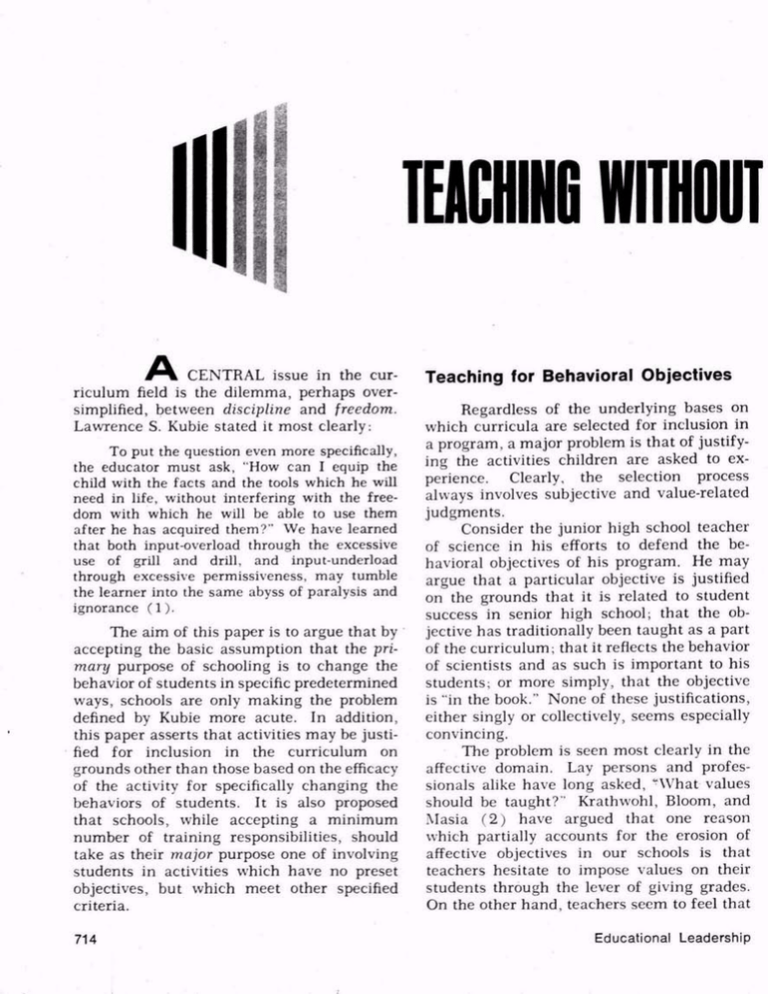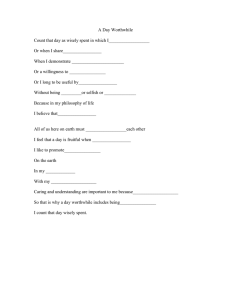
CENTRAL issue in the cur
riculum field is the dilemma, perhaps over
simplified, between discipline and freedom.
Lawrence S. Kubie stated it most clearly:
To put the question even more specifically,
the educator must ask, "How can I equip the
child with the facts and the tools which he will
need in life, without interfering with the free
dom with which he will be able to use them
after he has acquired them?" We have learned
that both input-overload through the excessive
use of grill and drill, and input-underload
through excessive permissiveness, may tumble
the learner into the same abyss of paralysis and
ignorance (1).
The aim of this paper is to argue that by
accepting the basic assumption that the p ri
mary purpose of schooling is to change the
behavior of students in specific predetermined
ways, schools are only making the problem
defined by Kubie more acute. In addition,
this paper asserts that activities may be justi
fied for inclusion in the curriculum on
grounds other than those based on the efficacy
of the activity for specifically changing the
behaviors of students. It is also proposed
that schools, while accepting a minimum
number of training responsibilities, should
take as their m ajor purpose one of involving
students in activities which have no preset
objectives, but which meet other specified
criteria.
714
Teaching for Behavioral Objectives
Regardless of the underlying bases on
which curricula are selected for inclusion in
a program, a major problem is that of justify
ing the activities children are asked to ex
perience. Clearly, the selection process
always involves subjective and value-related
judgments.
Consider the junior high school teacher
of science in his efforts to defend the be
havioral objectives of his program. He may
argue that a particular objective is justified
on the grounds that it is related to student
success in senior high school; that the ob
jective has traditionally been taught as a part
of the curriculum; that it reflects the behavior
of scientists and as such is important to his
students; or more simply, that the objective
is "in the book." None of these justifications,
either singly or collectively, seems especially
convincing.
The problem is seen most clearly in the
affective domain. Lay persons and profes
sionals alike have long asked, "What values
should be taught?" Krathwohl, Bloom, and
Masia (2) have argued that one reason
which partially accounts for the erosion of
affective objectives in our schools is that
teachers hesitate to impose values on their
students through the lever of giving grades.
On the other hand, teachers seem to feel that
Educational Leadership
SPECIFIC OBJECTIVES
JAMES D. RATHS*
manipulating students in the cognitive do
main is ethical. For instance, a science
teacher may want his students to acquire be
haviors associated with the scientific method.
Manifestly, there is no one scientific method,
just as there is no one view of justice, yet
teachers seem to feel no compunction about
"forcing" students to learn the scientific
method they have in mind while shying away
from teaching one view of justice.
It is important in terms of the central
thesis of this paper to consider the long range
implications a teacher and his students must
accept once it has been decided that all stu
dents are to acquire a specific instructional
objective. The teacher's task becomes at once
difficult and tedious. He must inform his
students of the objective to which they arc
expected to aspire; he must convince them of
the relevance of this objective to their lives;
he must give students the opportunity to
practice the behavior being taught; he must
diagnose individual difficulties encountered
by members of his group; he must make pre
scriptions of assignments based on his diag
noses and repeat the cycle again and again.
Needless to say, this "method" of instruction
has proved itself effective, if not provocative.
It is the training paradigm perfected during
both World Wars and utilized extensively in
the armed forces and in industry to prepare
persons for specific responsibilities.
April 1971
It is the rare teacher who implements
this procedure with the precision implied by
the foregoing description. Few teachers
have the energy, the knowledge important for
making diagnoses, the memory needed to
recall prescriptions, or the feedback capabili
ties of a computer. The ultimate training
program is the research-based IPI model used
experimentally in a few schools throughout
the country. This observation is not meant to
fault teachers as a group but merely to ob
serve that in terms of the ways schools are
organized, for example, teacher-student
ratios, availability of special technical as
sistance, etc., only the most gifted and dedi
cated teachers can offer an effective training
procedure to students. So instead of a rigor
ous training paradigm, most students are
presented with "grill and drill" techniques,
as cited by Kubie, repetitious to some and
meaningless to others. Yet even if all pro
grams could be set up on the basis of be
havioral objectives and even if strict training
paradigms could be established to meet the
objectives, who could argue that such a pro
gram would be other than tedious and ulti
mately stultifying? This last comment
applies both to the students and to the
* James D. Raths, Director, Bureau of Educa
tional Research and Field Services, College of
Education, University of Maryland, College Park
715
teacher. Usually, teaching for objectives is
dull work. Most of the student responses
are familiar ones and are anticipated by a
teacher who is fully aware of the range of
possible problems students might meet in
acquiring the behavior. Hopefully, both
teachers and students aspire to something
other than this.
Teaching Without Specific Objectives
To suggest that teachers plan programs
without specific instructional objectives seems
to fly in the face of many sacred beliefs
those dealing with progress, efficiency, suc
cess, and even rationality. On the other
hand, such a proposal evidently does not fly
in the face of current practices. Much to the
distress of empiricists (3, 4), teachers do
from time to time invite children to partici
pate in activities for which specific behavioral
objectives are rarely preset. Examples of
some of these activities include taking field
trips, acting in dramatic presentations, hav
ing free periods in school, participating in
school governments, putting out a class
newspaper, and many others. While teach
ers evidently hope that students, as indi
viduals, will acquire learnings from these
activities, the learnings are generally not
preset nor are they imposed on all the chil
dren in the class.
Instead, teachers may intend that these
activities will provide students with some of
the skills they will need in life, either through
the direct experience they undergo in the
classroom in carrying out the activity or
through subsequent follow-up activities. In
addition, teachers learn to expect that some
children will become bored with any single
activity whatever it is. This response can
be found in most classrooms at any one time
and teachers simply make plans to involve
those students suffering from momentary
ennui in other provocative activities later in
the day or week.
While carrying out a program composed
of such activities, a teacher must perform
many important and difficult tasks, but the
functions seem less perfunctory and more
challenging than those carried out under the
716
training regimen described previously. A
teacher must listen to the comments and
questions of his students with the intent of
clarifying their views and perceptions; he
must encourage students to reflect upon their
experiences through writings, poetry, draw
ings, and discussions; he must react to their
responses in ways that suggest individual
activities students may consider in following
up on their experiences. In these ways,
teachers provide an environment that is
sufficiently evocative to encourage children
to become informed and capable, but in indi
vidual ways that would be difficult to antici
pate either in the central offices of a board
of education or in the test construction
laboratories located at Palo Alto or Iowa City.
Criteria for
Worthwhile Activities
If we accept the argument that the ma
jor focus of our schools should be away from
activities designed to bring about specific
behavioral changes in students, then on what
basis can activities be justified for inclusion
in the curricula of our schools? This section
advances some criteria for identifying activi
ties that seem to have some inherent worth.
The criteria set down here for identifying
worthwhile activities are not advanced to
convince anyone of their wisdom as a set or
individually, but merely to suggest value
statements that might be used to justify
the selection of particular activities in a
curriculum.
The value statements are couched in
terms that can best be used in the following
manner. As a teacher contemplates an ac
tivity for his classroom, each of the value
statements may suggest ways the activity
might be altered. For instance, if a teacher
were to consider an assignment which re
quires students to write a report on Brazil, he
might revise his assignment to include one or
more of the value dimensions suggested by
the criteria. With all other things being
equal, the revised assignment would be con
sidered, according to these criteria, more
worthwhile than the original one.
A relevant question to raise at this point
Educational Leadership
is, "Worthwhile for whom?" The answer
necessarily is for the child and for society.
While there can be no empirical support for
this response, neither can any other activity
or behavioral objective be justified through
data.
about current social problems such as pollu
tion, war and peace, or of personal human
relations is more worthwhile than one that
is directed toward places (Mexico or Africa),
objects (birds or simple machines), or per
sons (Columbus or Shakespeare).
1. A ll other things being equal, one
activity is more worthwhile tlian another if
it permits children to make informed choices
in carrying out the activity and to reflect on
the consequences of their choices.
An activity that requires children to
select topics for study, resources for use, or
media for the display of ideas, after some
exploration of alternatives, is more worth
while than one that provides children with
no opportunities or another that gives choices
at rather mundane levels, for example, a
choice of now or this afternoon, or using a
pen or pencil.
4. A ll other things being equal, one ac
tivity is more worthu'hile than another if it
involves children with realia.
An activity that encourages children to
touch, handle, apply, manipulate, examine,
and collect real objects, materials, and arti
facts either in the classroom or on field trips
is more worthwhile than one that involves
children in the use of pictures, models, or
narrative accounts.
2. A ll other things being equal, one ac
tivity is more worthwhile than another if it
assigns to students active roles in the learning
situation rather than passive ones.
An activity that channels students' ener
gies into such roles as panel members, re
searchers, orators, observers, reporters,
interviewers, actors, surveyors, performers,
role players, or participants in simulation ex
ercises such as games is more worthwhile
than one which assigns students to tasks
such as listening in class to the teacher, filling
out a ditto sheet, responding to a drill session,
or participating in a routine teacher-led
discussion.
3. A ll other things being equal, one ac
tivity is more worthwhile than another if it
asks students to engage in inquiry into ideas,
applications of intellectual processes, or cur
rent problems, either personal or social.
An activity that directs children to be
come acquainted with ideas that transcend
traditional curricular areas, ideas such as
truth, beauty, worth, justice, or self-worth;
one that focuses children on intellectual
processes such as testing hypotheses, iden
tifying assumptions, or creating original
pieces of work which communicate personal
ideas or emotions; or one that raises questions
April 1971
5. A ll other things being equal, one ac
tivity is more worthwhile than another if
completion of the activity may be accom
plished sitccessfidly by children at several
different levels of ability.
An activity that can be completed suc
cessfully by children of diverse interests and
intellectual backgrounds is more worthwhile
than one which specifies in rigid terms only
one successful outcome of the activity.
Examples of the former are thinking assign
ments such as imagining, comparing, classi
fying, or summarizing, all of which allow
youngsters to operate on their own levels
without imposing a single standard on the
outcomes.
6. A ll other things being equal, one
activity is more worthwhile than another if
it asks students to examine in a new setting
an idea, an application of an intellectual
process, or a current problem which has been
previously studied.
An activity that builds on previous stu
dent work by directing a focus into n ovel
locations, n ew subject matter areas, or dif
ferent contexts is more worthwhile than one
that is completely unrelated to the previous
work of the students. (This position is an
example of one that is impossible to build
into every activity presented to students. Ob
viously a balance is needed between newareas of study and those which are related to
previous work. Value dimension number six
717
asserts the need for some continuity in a
program.)
7. A ll other things being equal, one ac
tivity is more worthwhile than another if it
requires students to examine topics or issues
that citizens in our society do not normally
examine and that are typically ignored by
the major communication media in the
nation.
An activity that deals with matters of
sex, religion, war and peace, the profit mo
tive, treatment of minorities, the workings of
the courts, the responsiveness of local gov
ernments to the needs of the people, the social
responsibilities of public corporations, for
eign influences in American media, social
class, and similar issues is more worthwhile
than an activity which deals with mundane
"school topics" such as quadratic equations
or short stories topics usually considered
safe and traditional.
and that efforts can be made to improve their
work are more worthwhile than ones that
merely suggest that once an assignment is
completed the first time, it is finished.
10. A ll other things being equal, one
activity is more worthwhile than another if it
involves students in the application and mas
tery of meaningful rules, standards, or
disciplines.
Using standards derived from students
as well as authorities, panel discussions can
be disciplined by procedures; reporting of
data can be disciplined by considerations of
control; essays can be regulated by consid
erations of style and syntax. Activities which
foster a sense of meaningful discipline, either
imposed or chosen by the children them
selves, are more worthwhile than ones that
ignore the need for the application of mean
ingful rules or standards.
8. A ll other things being equal, one
activity is more worthwhile than another if
it involves students and faculty members in
"risk" taking not a risk of life or limb, but
a risk of success or failure.
Activities that may receive criticism
from supervisors and parents on the basis of
"what's usually done," that may fail because
of unforeseen events or conditions, are more
worthwhile than activities that are relatively
risk-free using approaches which are con
doned openly by the community and the
school administration and which have served
teachers well in the.past.
11. A ll other things being equal, one
activity is more worthwhile than another if it
gives students a chance to share the planning,
the carrying out of a plan, or the results of
an activity with others.
One facet of the current trends in indi
vidualizing instruction found in some pro
grams is that of minimizing the chance for
children to work in groups and to learn the
problems inherent in any situation that calls
for individual desires to yield at times to
group requirements. An activity that asks
children to play a role in sharing responsi
bilities with others is more worthwhile than
one which limits such opportunity.
9. A ll other things being equal, one
activity is more worthwhile than another if it
requires students to rewrite, rehearse, and
polish their initial efforts.
Rather than having students perceive
assignments as "tasks to complete," activities
should provide time and opportunity for stu
dents to revise their themes in the light of
criticism, rehearse a play in front of an audi
ence, or practice an interviewing technique
to be used in a project so that they will begin
to see the value of doing a task well. Activi
ties that communicate to students that their
efforts are approximations of perfect work
12. A ll other things being equal, one
activity is more worthwhile than another if it
is relevant to the expressed purposes of the
students.
While a prizing of children's purposes
might well be protected by the value dimen
sion previously expressed, of providing
choices for children, it is important enough
to stress in a value dimension of its own. As
students are invited to express their own
interests and to define problems in which
they feel a personal involvement, and as the
activities of the curriculum reflect those in
terests, the ensuing activity will be more
718
Educational Leadership
worthwhile than one that is based on at
tributions of interests and concerns made by
teachers.
Evaluation
All of the foregoing is not to suggest that
school programs need not be evaluated. As
in the past, those activities which are justi
fied in terms of the objectives they are de
signed to meet can be evaluated through
criterion-referenced achievement tests. Other
procedures need to be developed to describe
school programs in terms of the character
istics of the activities which comprise the
programs. The following procedure might
serve as a way of communicating information
about a given course or program which would
be meaningful to administrators and parents.
Assume that a teacher accepted as the
major values of his program those previ
ously identified in this paper. (Presumably,
this procedure could be used for any set of
values.) He could periodically describe his
program using a chart similar to the one
presented in Table 1. The chart could be
completed according to the following ground
rules:
Obviously, not all of the value compo
nents identified in this section can be built
into a single activity. Also, not all the values
listed deserve the same amount of emphasis
in terms of time within a given program.
For example, some assignments involving
"risk" may be titillating for students and
teachers, but a program which has more than
a few activities reflecting the "risk" value
would probably be out of balance. Finally,
the list above is not exhaustive. It is meant
to illustrate values that might be used in
defining a program of worthwhile activities.
The value-criteria are merely working hy
potheses at this time, subject to analysis if
not empirical testing. Others are encouraged
to develop their own set of criteria.
Caveat
It must be emphasized that all teachers,
whether working at the first grade level or in
graduate school, generally need to do some
teaching for objectives as well as some teach
ing without specific objectives. Whitehead
has suggested that in terms of the rhythm of
education, many more of the tasks assigned
to younger children should be justified on
non-instrumental values, while those as
signed at the upper levels might reasonably
contain more performance-related activi
ties (5).
Column 1: This column would simply num
ber the activity for purposes of identification.
Column 2: This notation would place the
activity in the sequence of activities carried out
during the reporting period.
Column 3: This entry would be another
way of labeling the topics under study for pur
poses of identification.
Column 4: The number of students who
successfully completed the activity would be
Unit:
(1)
(2)
(5)
<6)
Number of
students
completing
activity
Estimated number
of hours of
participation
per student
1 2 3 4 5 6 7 8 9 10 11 12
15
2 hrs.
Date 3
Title of activity
1
Jan. 8
Experiment with
electricity
Justified by criteria .
(Check those relevant)
X
X
X
X
X
f —-•>_
Table 1.
April 1971
D<
(4)
Activity
number
>^—-v
___
(3)
Teacher's Log
719
entered here to communicate the extent to
which all students in the class were involved
with the activity.
Column 5: To give emphasis to the centrality of the activity to the scope of the course,
the estimation of the average number of hours
students spent on the activity would be entered
in this column.
Column 6: I n this column, teachers would
check those components of the activity which
in their eyes serve to justify it in their program.
In the example entered in the table, the teacher
has justified an activity, not in terms of what
students can do on finishing it that they could
not do before, but on the grounds that it gave
students a chance to make a choice (#1); in
volved them in active roles C#2); included ex
periences with realia (#4); provided various
levels of achievement which could be judged
as successful C#5); and required students to
apply meaningful standards to their work (#10).
If each line of every teacher's log were
punched on a computer card, a program
could easily be written which would yield
output describing the percentage of time
spent on each activity, and the number of
children who were involved with programs
under each value dimension. At present, no
generalizations are available which could be
used to rate definitively a given course de
scription as adequate or inadequate, based on
these data. Nevertheless, if a science pro
gram profile indicated that almost no time
was spent with students in active roles, if
students were almost never involved with
realia, and if students had few opportunities
to apply meaningful rules or standards to
their work, then a person sharing the values
espoused in this paper would have serious
reservations about the quality of that par
ticular science program.
In summary, the argument has been
presented that an activity can be justified in
terms other than those associated with its
instrumental value for changing the behavior
of students. In addition, this paper has pre
sented a set of criteria for identifying worth
while activities, proposed a modest procedure
for describing programs in terms of those
criteria, and issued an invitation for others
to present alternative criteria. Most of all, it
has asked that some concern be directed
toward the quality of opportunities for experi
ences offered through our schools.
References
1. L awrence S. Kubie. "Research on Pro
tecting Preconscious Functions in Education." (n.d.)
Mimeo. p. 4. Also see this paper in: A. Harry
Passow, editor. Nurturing Individual Potential.
Washington, D.C.: Association for Supervision and
Curriculum Development, 1964. pp. 28-42.
2. D. R. Krathwohl, B. S. Bloom, and B. B.
Masia. Ta\~ouomy of Educational Objectives Hand
book II: Affective Domain. New York: David McKay
Company, Inc., 1964. p. 16.
3. \V. James Popham. The Teacher-Empiri
cist. Los Angeles: Aegeus Press, 1965.
4. Henry H. Walbesser. Constructing Be
havioral Objectives. College Park: Bureau of Edu
cational Research and Field Services, University of
Maryland, 1970.
5. A. N. Whitehead. The Aims of Education.
New York: Mentor Books, 1929. pp. 27ff.
Q
ETHNIC MODIFICATION
OF TH<E CURRICULUM
MaXJne DlinfeS Pmlessor of Education, Indiana University
Report of an ASCD-sponsored conference which studied the need for immediate curriculum
evaluation and revision in terms of a pluralistic society.
52 pages
$1.00
NEA Stock Number: 611-17832
Association for Supervision and Curriculum Development, NEA
1201 Sixteenth Street, N.W. • Washington, D.C. 20036
720
Educational Leadership
Copyright © 1971 by the Association for Supervision and Curriculum
Development. All rights reserved.



